Electrical Power Production, Consumption, and Sustainability in the UK
VerifiedAdded on 2020/05/03
|9
|1873
|117
Report
AI Summary
This report provides a comprehensive overview of electrical power in the United Kingdom, covering generation, transmission, and consumption. It delves into various aspects, including the sources of electrical energy, both renewable and non-renewable, with a focus on fossil fuels, nuclear energy, and renewable sources like biomass, wind, wave, and solar. The report details the UK's network size, including generating capacity, maximum demand, and annual electricity usage. It also explores the distribution and transmission systems, highlighting the national high voltage grid and interconnectors with neighboring countries for import and export. Furthermore, the report analyzes the growth in demand and offers a personal commentary on the UK's efforts towards energy conservation and sustainability, emphasizing the need to reduce reliance on non-renewable sources. The document includes figures and projections on power demand and consumption, as well as references to relevant sources.
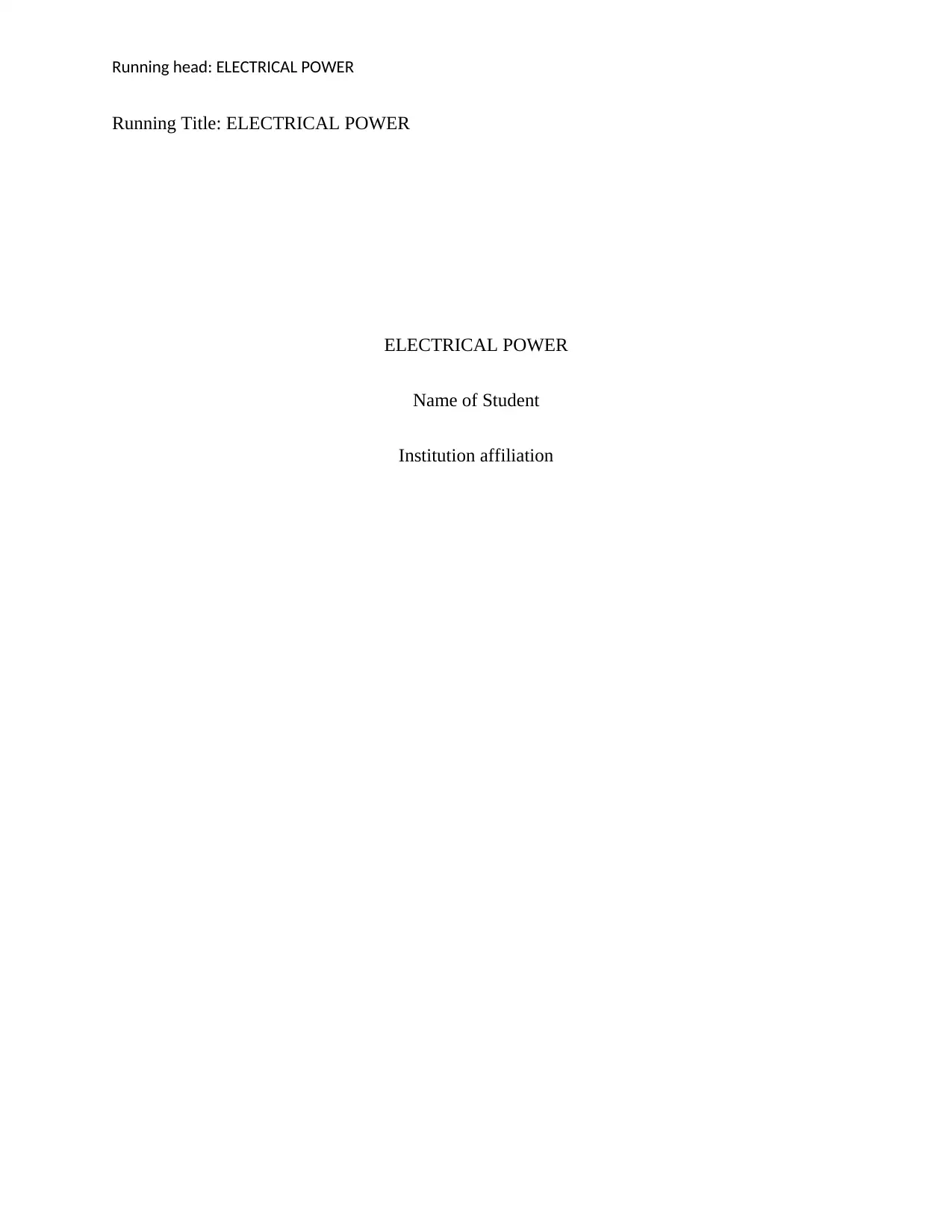
Running head: ELECTRICAL POWER
Running Title: ELECTRICAL POWER
ELECTRICAL POWER
Name of Student
Institution affiliation
Running Title: ELECTRICAL POWER
ELECTRICAL POWER
Name of Student
Institution affiliation
Paraphrase This Document
Need a fresh take? Get an instant paraphrase of this document with our AI Paraphraser
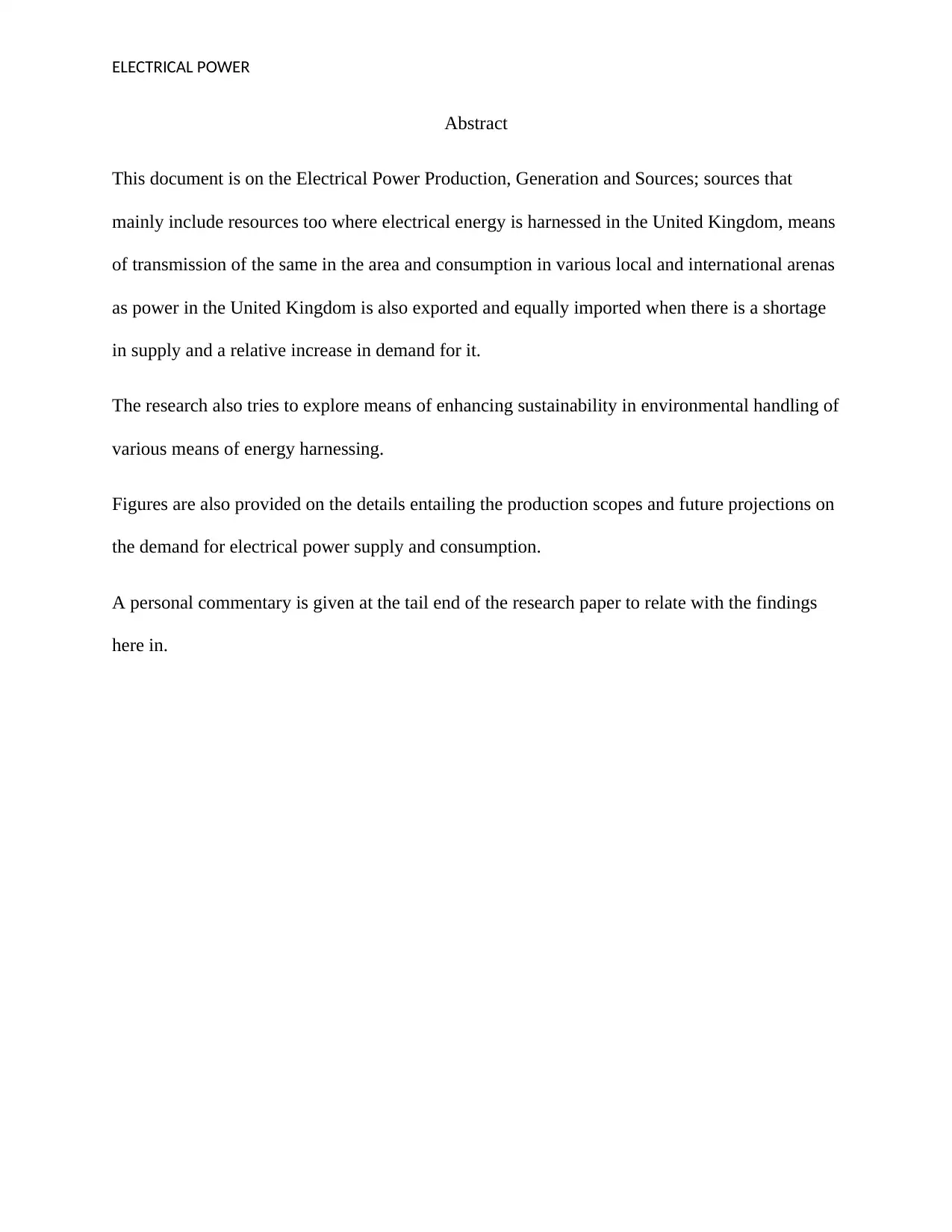
ELECTRICAL POWER
Abstract
This document is on the Electrical Power Production, Generation and Sources; sources that
mainly include resources too where electrical energy is harnessed in the United Kingdom, means
of transmission of the same in the area and consumption in various local and international arenas
as power in the United Kingdom is also exported and equally imported when there is a shortage
in supply and a relative increase in demand for it.
The research also tries to explore means of enhancing sustainability in environmental handling of
various means of energy harnessing.
Figures are also provided on the details entailing the production scopes and future projections on
the demand for electrical power supply and consumption.
A personal commentary is given at the tail end of the research paper to relate with the findings
here in.
Abstract
This document is on the Electrical Power Production, Generation and Sources; sources that
mainly include resources too where electrical energy is harnessed in the United Kingdom, means
of transmission of the same in the area and consumption in various local and international arenas
as power in the United Kingdom is also exported and equally imported when there is a shortage
in supply and a relative increase in demand for it.
The research also tries to explore means of enhancing sustainability in environmental handling of
various means of energy harnessing.
Figures are also provided on the details entailing the production scopes and future projections on
the demand for electrical power supply and consumption.
A personal commentary is given at the tail end of the research paper to relate with the findings
here in.
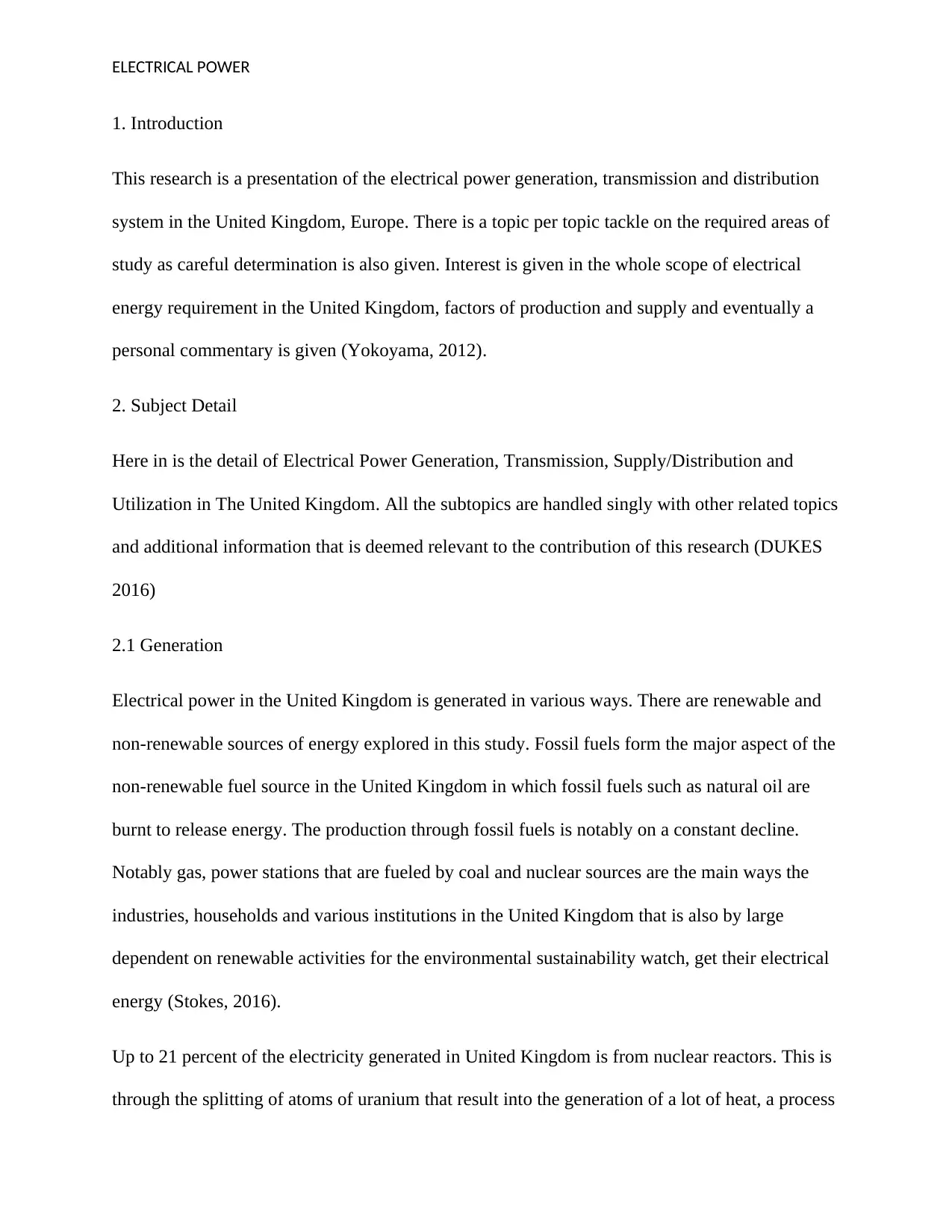
ELECTRICAL POWER
1. Introduction
This research is a presentation of the electrical power generation, transmission and distribution
system in the United Kingdom, Europe. There is a topic per topic tackle on the required areas of
study as careful determination is also given. Interest is given in the whole scope of electrical
energy requirement in the United Kingdom, factors of production and supply and eventually a
personal commentary is given (Yokoyama, 2012).
2. Subject Detail
Here in is the detail of Electrical Power Generation, Transmission, Supply/Distribution and
Utilization in The United Kingdom. All the subtopics are handled singly with other related topics
and additional information that is deemed relevant to the contribution of this research (DUKES
2016)
2.1 Generation
Electrical power in the United Kingdom is generated in various ways. There are renewable and
non-renewable sources of energy explored in this study. Fossil fuels form the major aspect of the
non-renewable fuel source in the United Kingdom in which fossil fuels such as natural oil are
burnt to release energy. The production through fossil fuels is notably on a constant decline.
Notably gas, power stations that are fueled by coal and nuclear sources are the main ways the
industries, households and various institutions in the United Kingdom that is also by large
dependent on renewable activities for the environmental sustainability watch, get their electrical
energy (Stokes, 2016).
Up to 21 percent of the electricity generated in United Kingdom is from nuclear reactors. This is
through the splitting of atoms of uranium that result into the generation of a lot of heat, a process
1. Introduction
This research is a presentation of the electrical power generation, transmission and distribution
system in the United Kingdom, Europe. There is a topic per topic tackle on the required areas of
study as careful determination is also given. Interest is given in the whole scope of electrical
energy requirement in the United Kingdom, factors of production and supply and eventually a
personal commentary is given (Yokoyama, 2012).
2. Subject Detail
Here in is the detail of Electrical Power Generation, Transmission, Supply/Distribution and
Utilization in The United Kingdom. All the subtopics are handled singly with other related topics
and additional information that is deemed relevant to the contribution of this research (DUKES
2016)
2.1 Generation
Electrical power in the United Kingdom is generated in various ways. There are renewable and
non-renewable sources of energy explored in this study. Fossil fuels form the major aspect of the
non-renewable fuel source in the United Kingdom in which fossil fuels such as natural oil are
burnt to release energy. The production through fossil fuels is notably on a constant decline.
Notably gas, power stations that are fueled by coal and nuclear sources are the main ways the
industries, households and various institutions in the United Kingdom that is also by large
dependent on renewable activities for the environmental sustainability watch, get their electrical
energy (Stokes, 2016).
Up to 21 percent of the electricity generated in United Kingdom is from nuclear reactors. This is
through the splitting of atoms of uranium that result into the generation of a lot of heat, a process
⊘ This is a preview!⊘
Do you want full access?
Subscribe today to unlock all pages.

Trusted by 1+ million students worldwide
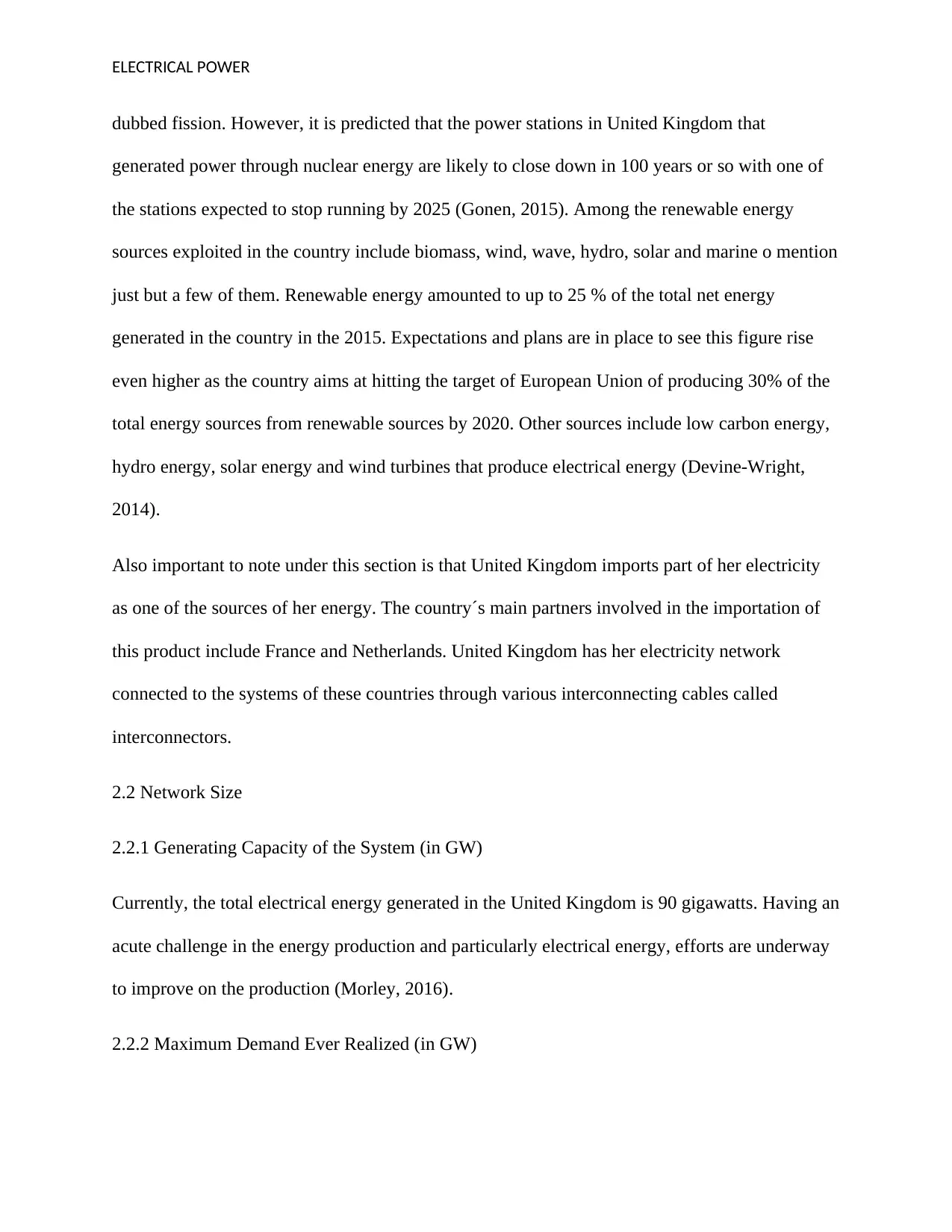
ELECTRICAL POWER
dubbed fission. However, it is predicted that the power stations in United Kingdom that
generated power through nuclear energy are likely to close down in 100 years or so with one of
the stations expected to stop running by 2025 (Gonen, 2015). Among the renewable energy
sources exploited in the country include biomass, wind, wave, hydro, solar and marine o mention
just but a few of them. Renewable energy amounted to up to 25 % of the total net energy
generated in the country in the 2015. Expectations and plans are in place to see this figure rise
even higher as the country aims at hitting the target of European Union of producing 30% of the
total energy sources from renewable sources by 2020. Other sources include low carbon energy,
hydro energy, solar energy and wind turbines that produce electrical energy (Devine-Wright,
2014).
Also important to note under this section is that United Kingdom imports part of her electricity
as one of the sources of her energy. The country´s main partners involved in the importation of
this product include France and Netherlands. United Kingdom has her electricity network
connected to the systems of these countries through various interconnecting cables called
interconnectors.
2.2 Network Size
2.2.1 Generating Capacity of the System (in GW)
Currently, the total electrical energy generated in the United Kingdom is 90 gigawatts. Having an
acute challenge in the energy production and particularly electrical energy, efforts are underway
to improve on the production (Morley, 2016).
2.2.2 Maximum Demand Ever Realized (in GW)
dubbed fission. However, it is predicted that the power stations in United Kingdom that
generated power through nuclear energy are likely to close down in 100 years or so with one of
the stations expected to stop running by 2025 (Gonen, 2015). Among the renewable energy
sources exploited in the country include biomass, wind, wave, hydro, solar and marine o mention
just but a few of them. Renewable energy amounted to up to 25 % of the total net energy
generated in the country in the 2015. Expectations and plans are in place to see this figure rise
even higher as the country aims at hitting the target of European Union of producing 30% of the
total energy sources from renewable sources by 2020. Other sources include low carbon energy,
hydro energy, solar energy and wind turbines that produce electrical energy (Devine-Wright,
2014).
Also important to note under this section is that United Kingdom imports part of her electricity
as one of the sources of her energy. The country´s main partners involved in the importation of
this product include France and Netherlands. United Kingdom has her electricity network
connected to the systems of these countries through various interconnecting cables called
interconnectors.
2.2 Network Size
2.2.1 Generating Capacity of the System (in GW)
Currently, the total electrical energy generated in the United Kingdom is 90 gigawatts. Having an
acute challenge in the energy production and particularly electrical energy, efforts are underway
to improve on the production (Morley, 2016).
2.2.2 Maximum Demand Ever Realized (in GW)
Paraphrase This Document
Need a fresh take? Get an instant paraphrase of this document with our AI Paraphraser
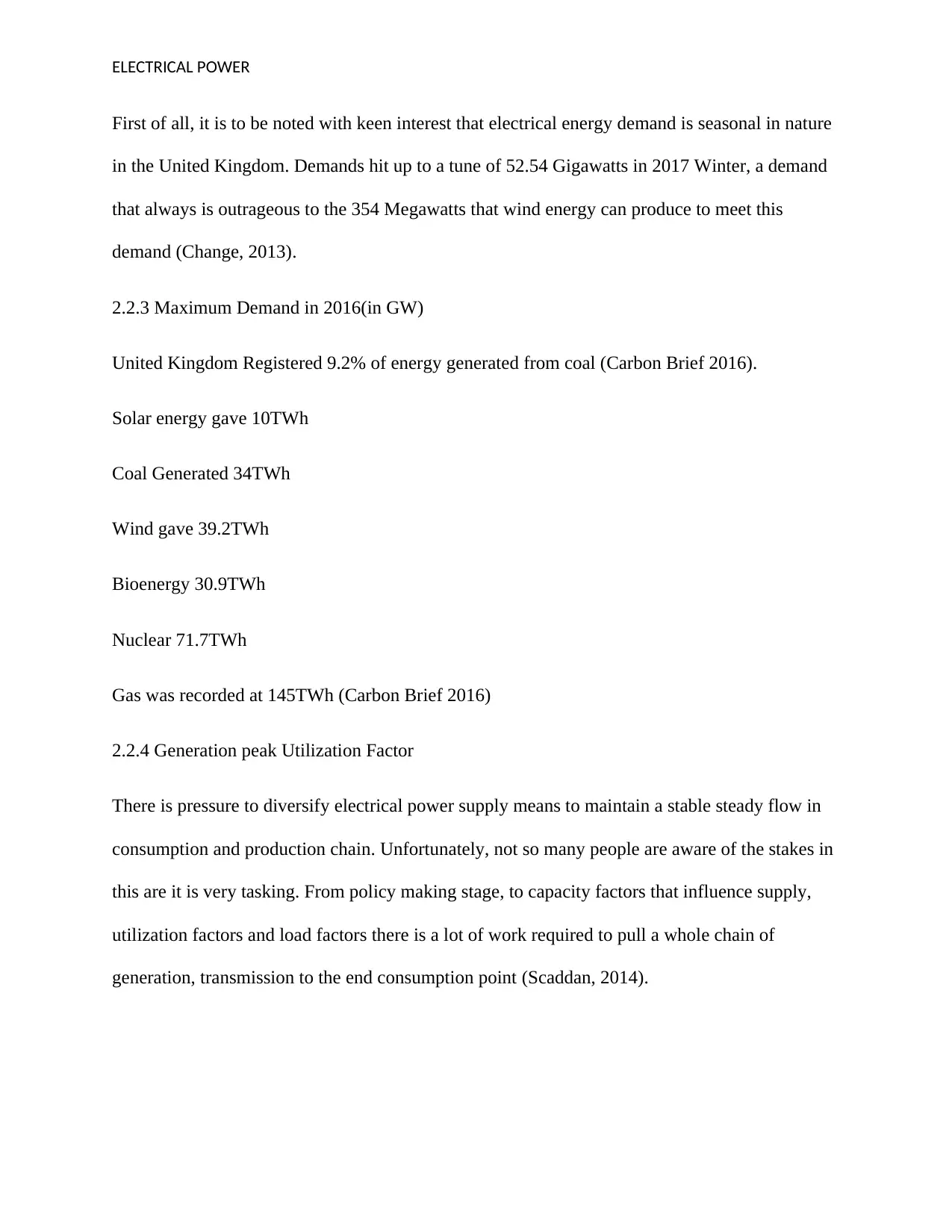
ELECTRICAL POWER
First of all, it is to be noted with keen interest that electrical energy demand is seasonal in nature
in the United Kingdom. Demands hit up to a tune of 52.54 Gigawatts in 2017 Winter, a demand
that always is outrageous to the 354 Megawatts that wind energy can produce to meet this
demand (Change, 2013).
2.2.3 Maximum Demand in 2016(in GW)
United Kingdom Registered 9.2% of energy generated from coal (Carbon Brief 2016).
Solar energy gave 10TWh
Coal Generated 34TWh
Wind gave 39.2TWh
Bioenergy 30.9TWh
Nuclear 71.7TWh
Gas was recorded at 145TWh (Carbon Brief 2016)
2.2.4 Generation peak Utilization Factor
There is pressure to diversify electrical power supply means to maintain a stable steady flow in
consumption and production chain. Unfortunately, not so many people are aware of the stakes in
this are it is very tasking. From policy making stage, to capacity factors that influence supply,
utilization factors and load factors there is a lot of work required to pull a whole chain of
generation, transmission to the end consumption point (Scaddan, 2014).
First of all, it is to be noted with keen interest that electrical energy demand is seasonal in nature
in the United Kingdom. Demands hit up to a tune of 52.54 Gigawatts in 2017 Winter, a demand
that always is outrageous to the 354 Megawatts that wind energy can produce to meet this
demand (Change, 2013).
2.2.3 Maximum Demand in 2016(in GW)
United Kingdom Registered 9.2% of energy generated from coal (Carbon Brief 2016).
Solar energy gave 10TWh
Coal Generated 34TWh
Wind gave 39.2TWh
Bioenergy 30.9TWh
Nuclear 71.7TWh
Gas was recorded at 145TWh (Carbon Brief 2016)
2.2.4 Generation peak Utilization Factor
There is pressure to diversify electrical power supply means to maintain a stable steady flow in
consumption and production chain. Unfortunately, not so many people are aware of the stakes in
this are it is very tasking. From policy making stage, to capacity factors that influence supply,
utilization factors and load factors there is a lot of work required to pull a whole chain of
generation, transmission to the end consumption point (Scaddan, 2014).
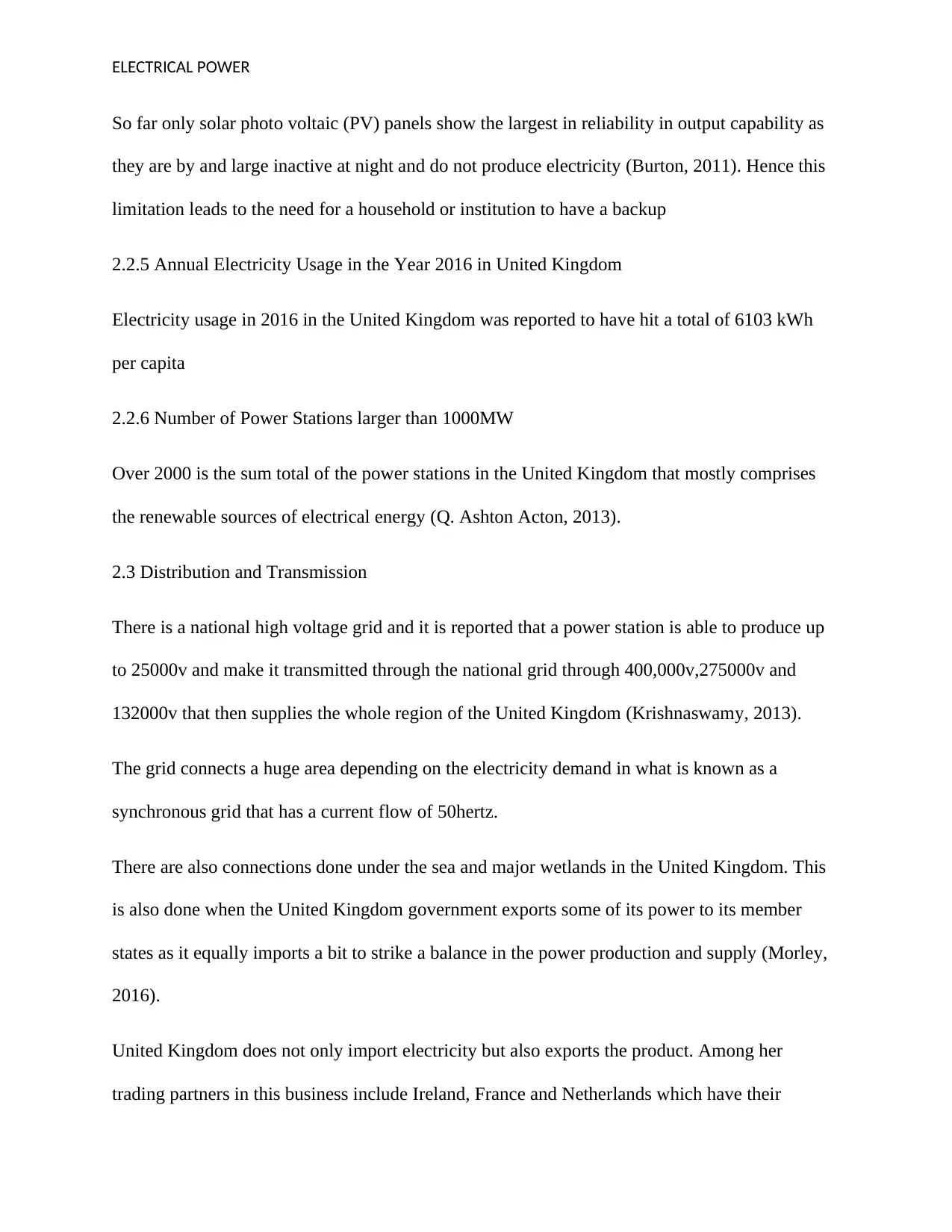
ELECTRICAL POWER
So far only solar photo voltaic (PV) panels show the largest in reliability in output capability as
they are by and large inactive at night and do not produce electricity (Burton, 2011). Hence this
limitation leads to the need for a household or institution to have a backup
2.2.5 Annual Electricity Usage in the Year 2016 in United Kingdom
Electricity usage in 2016 in the United Kingdom was reported to have hit a total of 6103 kWh
per capita
2.2.6 Number of Power Stations larger than 1000MW
Over 2000 is the sum total of the power stations in the United Kingdom that mostly comprises
the renewable sources of electrical energy (Q. Ashton Acton, 2013).
2.3 Distribution and Transmission
There is a national high voltage grid and it is reported that a power station is able to produce up
to 25000v and make it transmitted through the national grid through 400,000v,275000v and
132000v that then supplies the whole region of the United Kingdom (Krishnaswamy, 2013).
The grid connects a huge area depending on the electricity demand in what is known as a
synchronous grid that has a current flow of 50hertz.
There are also connections done under the sea and major wetlands in the United Kingdom. This
is also done when the United Kingdom government exports some of its power to its member
states as it equally imports a bit to strike a balance in the power production and supply (Morley,
2016).
United Kingdom does not only import electricity but also exports the product. Among her
trading partners in this business include Ireland, France and Netherlands which have their
So far only solar photo voltaic (PV) panels show the largest in reliability in output capability as
they are by and large inactive at night and do not produce electricity (Burton, 2011). Hence this
limitation leads to the need for a household or institution to have a backup
2.2.5 Annual Electricity Usage in the Year 2016 in United Kingdom
Electricity usage in 2016 in the United Kingdom was reported to have hit a total of 6103 kWh
per capita
2.2.6 Number of Power Stations larger than 1000MW
Over 2000 is the sum total of the power stations in the United Kingdom that mostly comprises
the renewable sources of electrical energy (Q. Ashton Acton, 2013).
2.3 Distribution and Transmission
There is a national high voltage grid and it is reported that a power station is able to produce up
to 25000v and make it transmitted through the national grid through 400,000v,275000v and
132000v that then supplies the whole region of the United Kingdom (Krishnaswamy, 2013).
The grid connects a huge area depending on the electricity demand in what is known as a
synchronous grid that has a current flow of 50hertz.
There are also connections done under the sea and major wetlands in the United Kingdom. This
is also done when the United Kingdom government exports some of its power to its member
states as it equally imports a bit to strike a balance in the power production and supply (Morley,
2016).
United Kingdom does not only import electricity but also exports the product. Among her
trading partners in this business include Ireland, France and Netherlands which have their
⊘ This is a preview!⊘
Do you want full access?
Subscribe today to unlock all pages.

Trusted by 1+ million students worldwide
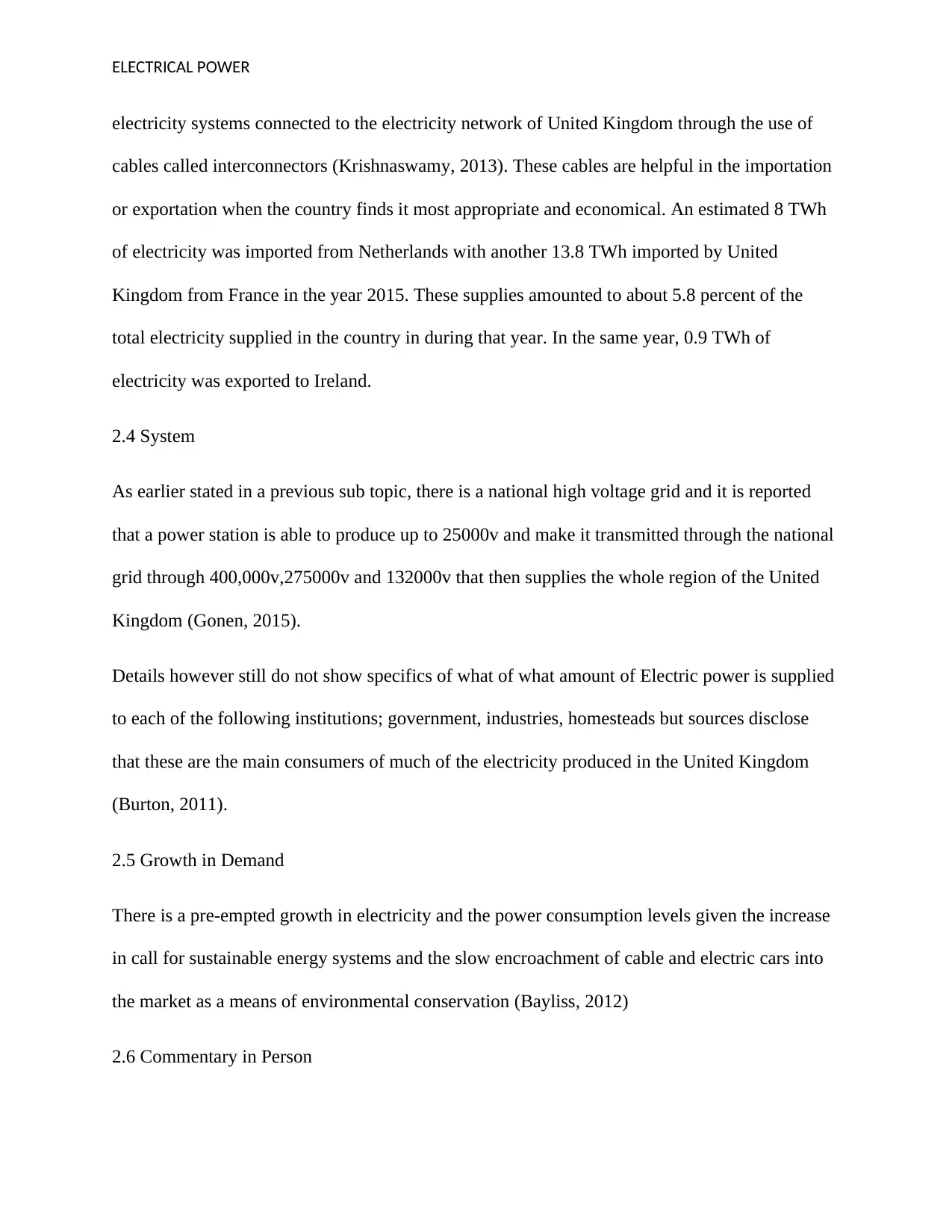
ELECTRICAL POWER
electricity systems connected to the electricity network of United Kingdom through the use of
cables called interconnectors (Krishnaswamy, 2013). These cables are helpful in the importation
or exportation when the country finds it most appropriate and economical. An estimated 8 TWh
of electricity was imported from Netherlands with another 13.8 TWh imported by United
Kingdom from France in the year 2015. These supplies amounted to about 5.8 percent of the
total electricity supplied in the country in during that year. In the same year, 0.9 TWh of
electricity was exported to Ireland.
2.4 System
As earlier stated in a previous sub topic, there is a national high voltage grid and it is reported
that a power station is able to produce up to 25000v and make it transmitted through the national
grid through 400,000v,275000v and 132000v that then supplies the whole region of the United
Kingdom (Gonen, 2015).
Details however still do not show specifics of what of what amount of Electric power is supplied
to each of the following institutions; government, industries, homesteads but sources disclose
that these are the main consumers of much of the electricity produced in the United Kingdom
(Burton, 2011).
2.5 Growth in Demand
There is a pre-empted growth in electricity and the power consumption levels given the increase
in call for sustainable energy systems and the slow encroachment of cable and electric cars into
the market as a means of environmental conservation (Bayliss, 2012)
2.6 Commentary in Person
electricity systems connected to the electricity network of United Kingdom through the use of
cables called interconnectors (Krishnaswamy, 2013). These cables are helpful in the importation
or exportation when the country finds it most appropriate and economical. An estimated 8 TWh
of electricity was imported from Netherlands with another 13.8 TWh imported by United
Kingdom from France in the year 2015. These supplies amounted to about 5.8 percent of the
total electricity supplied in the country in during that year. In the same year, 0.9 TWh of
electricity was exported to Ireland.
2.4 System
As earlier stated in a previous sub topic, there is a national high voltage grid and it is reported
that a power station is able to produce up to 25000v and make it transmitted through the national
grid through 400,000v,275000v and 132000v that then supplies the whole region of the United
Kingdom (Gonen, 2015).
Details however still do not show specifics of what of what amount of Electric power is supplied
to each of the following institutions; government, industries, homesteads but sources disclose
that these are the main consumers of much of the electricity produced in the United Kingdom
(Burton, 2011).
2.5 Growth in Demand
There is a pre-empted growth in electricity and the power consumption levels given the increase
in call for sustainable energy systems and the slow encroachment of cable and electric cars into
the market as a means of environmental conservation (Bayliss, 2012)
2.6 Commentary in Person
Paraphrase This Document
Need a fresh take? Get an instant paraphrase of this document with our AI Paraphraser
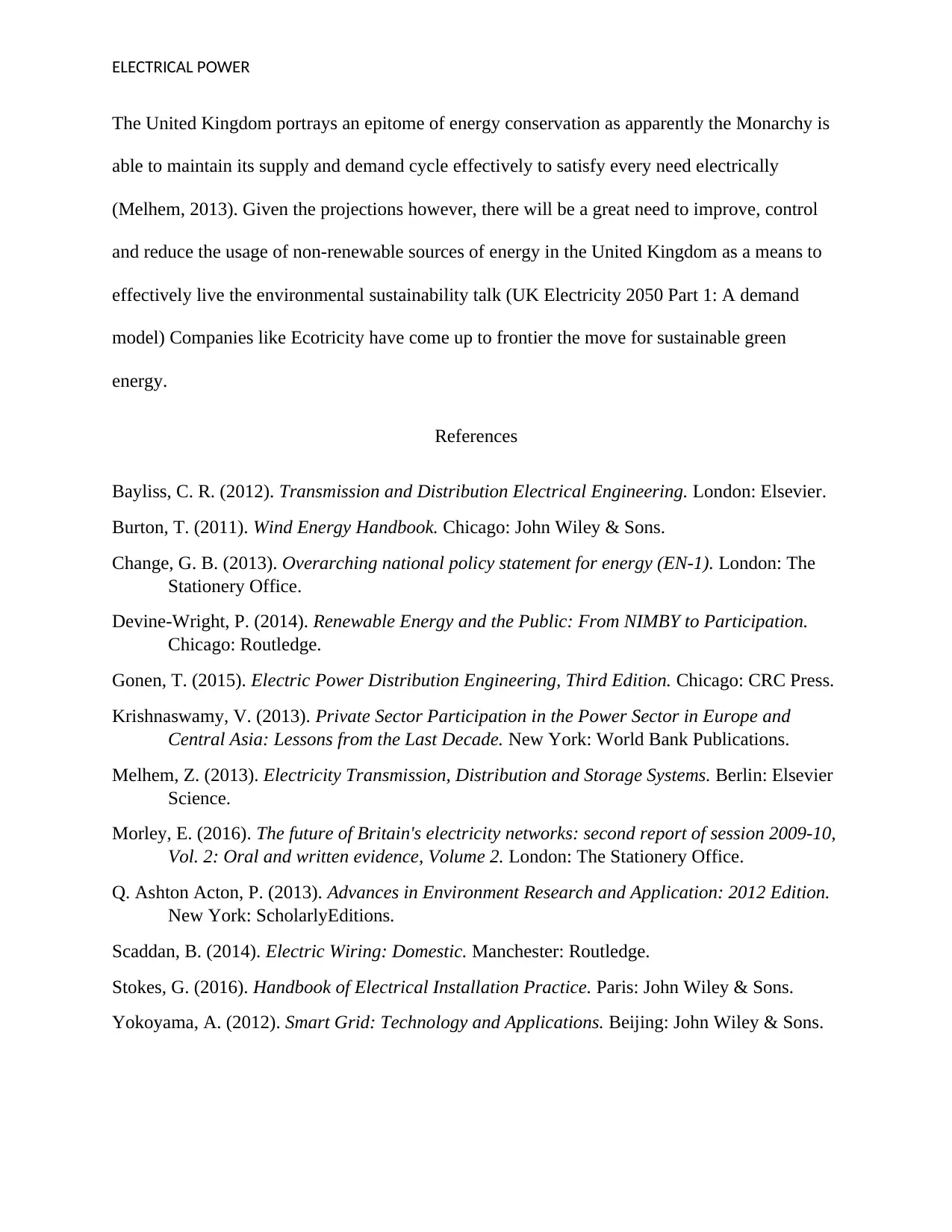
ELECTRICAL POWER
The United Kingdom portrays an epitome of energy conservation as apparently the Monarchy is
able to maintain its supply and demand cycle effectively to satisfy every need electrically
(Melhem, 2013). Given the projections however, there will be a great need to improve, control
and reduce the usage of non-renewable sources of energy in the United Kingdom as a means to
effectively live the environmental sustainability talk (UK Electricity 2050 Part 1: A demand
model) Companies like Ecotricity have come up to frontier the move for sustainable green
energy.
References
Bayliss, C. R. (2012). Transmission and Distribution Electrical Engineering. London: Elsevier.
Burton, T. (2011). Wind Energy Handbook. Chicago: John Wiley & Sons.
Change, G. B. (2013). Overarching national policy statement for energy (EN-1). London: The
Stationery Office.
Devine-Wright, P. (2014). Renewable Energy and the Public: From NIMBY to Participation.
Chicago: Routledge.
Gonen, T. (2015). Electric Power Distribution Engineering, Third Edition. Chicago: CRC Press.
Krishnaswamy, V. (2013). Private Sector Participation in the Power Sector in Europe and
Central Asia: Lessons from the Last Decade. New York: World Bank Publications.
Melhem, Z. (2013). Electricity Transmission, Distribution and Storage Systems. Berlin: Elsevier
Science.
Morley, E. (2016). The future of Britain's electricity networks: second report of session 2009-10,
Vol. 2: Oral and written evidence, Volume 2. London: The Stationery Office.
Q. Ashton Acton, P. (2013). Advances in Environment Research and Application: 2012 Edition.
New York: ScholarlyEditions.
Scaddan, B. (2014). Electric Wiring: Domestic. Manchester: Routledge.
Stokes, G. (2016). Handbook of Electrical Installation Practice. Paris: John Wiley & Sons.
Yokoyama, A. (2012). Smart Grid: Technology and Applications. Beijing: John Wiley & Sons.
The United Kingdom portrays an epitome of energy conservation as apparently the Monarchy is
able to maintain its supply and demand cycle effectively to satisfy every need electrically
(Melhem, 2013). Given the projections however, there will be a great need to improve, control
and reduce the usage of non-renewable sources of energy in the United Kingdom as a means to
effectively live the environmental sustainability talk (UK Electricity 2050 Part 1: A demand
model) Companies like Ecotricity have come up to frontier the move for sustainable green
energy.
References
Bayliss, C. R. (2012). Transmission and Distribution Electrical Engineering. London: Elsevier.
Burton, T. (2011). Wind Energy Handbook. Chicago: John Wiley & Sons.
Change, G. B. (2013). Overarching national policy statement for energy (EN-1). London: The
Stationery Office.
Devine-Wright, P. (2014). Renewable Energy and the Public: From NIMBY to Participation.
Chicago: Routledge.
Gonen, T. (2015). Electric Power Distribution Engineering, Third Edition. Chicago: CRC Press.
Krishnaswamy, V. (2013). Private Sector Participation in the Power Sector in Europe and
Central Asia: Lessons from the Last Decade. New York: World Bank Publications.
Melhem, Z. (2013). Electricity Transmission, Distribution and Storage Systems. Berlin: Elsevier
Science.
Morley, E. (2016). The future of Britain's electricity networks: second report of session 2009-10,
Vol. 2: Oral and written evidence, Volume 2. London: The Stationery Office.
Q. Ashton Acton, P. (2013). Advances in Environment Research and Application: 2012 Edition.
New York: ScholarlyEditions.
Scaddan, B. (2014). Electric Wiring: Domestic. Manchester: Routledge.
Stokes, G. (2016). Handbook of Electrical Installation Practice. Paris: John Wiley & Sons.
Yokoyama, A. (2012). Smart Grid: Technology and Applications. Beijing: John Wiley & Sons.

ELECTRICAL POWER
⊘ This is a preview!⊘
Do you want full access?
Subscribe today to unlock all pages.

Trusted by 1+ million students worldwide
1 out of 9
Related Documents
Your All-in-One AI-Powered Toolkit for Academic Success.
+13062052269
info@desklib.com
Available 24*7 on WhatsApp / Email
![[object Object]](/_next/static/media/star-bottom.7253800d.svg)
Unlock your academic potential
Copyright © 2020–2025 A2Z Services. All Rights Reserved. Developed and managed by ZUCOL.





